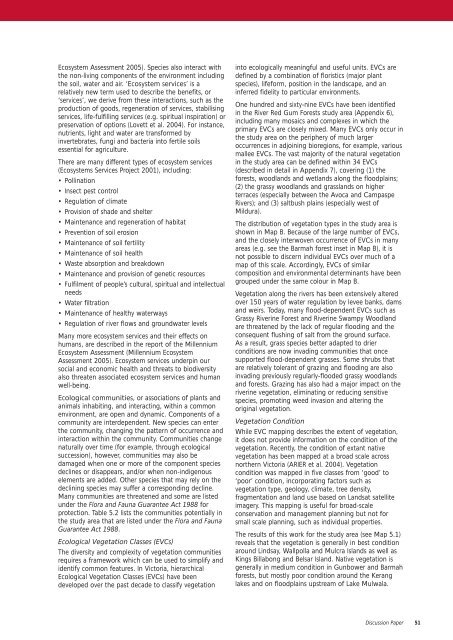Discussion Paper - Part A - Victorian Environmental Assessment ...
Discussion Paper - Part A - Victorian Environmental Assessment ...
Discussion Paper - Part A - Victorian Environmental Assessment ...
- No tags were found...
Create successful ePaper yourself
Turn your PDF publications into a flip-book with our unique Google optimized e-Paper software.
Ecosystem <strong>Assessment</strong> 2005). Species also interact withthe non-living components of the environment includingthe soil, water and air. ‘Ecosystem services’ is arelatively new term used to describe the benefits, or‘services’, we derive from these interactions, such as theproduction of goods, regeneration of services, stabilisingservices, life-fulfilling services (e.g. spiritual inspiration) orpreservation of options (Lovett et al. 2004). For instance,nutrients, light and water are transformed byinvertebrates, fungi and bacteria into fertile soilsessential for agriculture.There are many different types of ecosystem services(Ecosystems Services Project 2001), including:• Pollination• Insect pest control• Regulation of climate• Provision of shade and shelter• Maintenance and regeneration of habitat• Prevention of soil erosion• Maintenance of soil fertility• Maintenance of soil health• Waste absorption and breakdown• Maintenance and provision of genetic resources• Fulfilment of people’s cultural, spiritual and intellectualneeds• Water filtration• Maintenance of healthy waterways• Regulation of river flows and groundwater levelsMany more ecosystem services and their effects onhumans, are described in the report of the MillenniumEcosystem <strong>Assessment</strong> (Millennium Ecosystem<strong>Assessment</strong> 2005). Ecosystem services underpin oursocial and economic health and threats to biodiversityalso threaten associated ecosystem services and humanwell-being.Ecological communities, or associations of plants andanimals inhabiting, and interacting, within a commonenvironment, are open and dynamic. Components of acommunity are interdependent. New species can enterthe community, changing the pattern of occurrence andinteraction within the community. Communities changenaturally over time (for example, through ecologicalsuccession), however, communities may also bedamaged when one or more of the component speciesdeclines or disappears, and/or when non-indigenouselements are added. Other species that may rely on thedeclining species may suffer a corresponding decline.Many communities are threatened and some are listedunder the Flora and Fauna Guarantee Act 1988 forprotection. Table 5.2 lists the communities potentially inthe study area that are listed under the Flora and FaunaGuarantee Act 1988.Ecological Vegetation Classes (EVCs)The diversity and complexity of vegetation communitiesrequires a framework which can be used to simplify andidentify common features. In Victoria, hierarchicalEcological Vegetation Classes (EVCs) have beendeveloped over the past decade to classify vegetationinto ecologically meaningful and useful units. EVCs aredefined by a combination of floristics (major plantspecies), lifeform, position in the landscape, and aninferred fidelity to particular environments.One hundred and sixty-nine EVCs have been identifiedin the River Red Gum Forests study area (Appendix 6),including many mosaics and complexes in which theprimary EVCs are closely mixed. Many EVCs only occur inthe study area on the periphery of much largeroccurrences in adjoining bioregions, for example, variousmallee EVCs. The vast majority of the natural vegetationin the study area can be defined within 34 EVCs(described in detail in Appendix 7), covering (1) theforests, woodlands and wetlands along the floodplains;(2) the grassy woodlands and grasslands on higherterraces (especially between the Avoca and CampaspeRivers); and (3) saltbush plains (especially west ofMildura).The distribution of vegetation types in the study area isshown in Map B. Because of the large number of EVCs,and the closely interwoven occurrence of EVCs in manyareas (e.g. see the Barmah forest inset in Map B), it isnot possible to discern individual EVCs over much of amap of this scale. Accordingly, EVCs of similarcomposition and environmental determinants have beengrouped under the same colour in Map B.Vegetation along the rivers has been extensively alteredover 150 years of water regulation by levee banks, damsand weirs. Today, many flood-dependent EVCs such asGrassy Riverine Forest and Riverine Swampy Woodlandare threatened by the lack of regular flooding and theconsequent flushing of salt from the ground surface.As a result, grass species better adapted to drierconditions are now invading communities that oncesupported flood-dependent grasses. Some shrubs thatare relatively tolerant of grazing and flooding are alsoinvading previously regularly-flooded grassy woodlandsand forests. Grazing has also had a major impact on theriverine vegetation, eliminating or reducing sensitivespecies, promoting weed invasion and altering theoriginal vegetation.Vegetation ConditionWhile EVC mapping describes the extent of vegetation,it does not provide information on the condition of thevegetation. Recently, the condition of extant nativevegetation has been mapped at a broad scale acrossnorthern Victoria (ARIER et al. 2004). Vegetationcondition was mapped in five classes from ‘good’ to‘poor’ condition, incorporating factors such asvegetation type, geology, climate, tree density,fragmentation and land use based on Landsat satelliteimagery. This mapping is useful for broad-scaleconservation and management planning but not forsmall scale planning, such as individual properties.The results of this work for the study area (see Map 5.1)reveals that the vegetation is generally in best conditionaround Lindsay, Wallpolla and Mulcra Islands as well asKings Billabong and Belsar Island. Native vegetation isgenerally in medium condition in Gunbower and Barmahforests, but mostly poor condition around the Keranglakes and on floodplains upstream of Lake Mulwala.<strong>Discussion</strong> <strong>Paper</strong>51
















